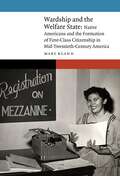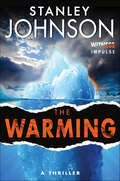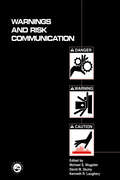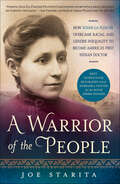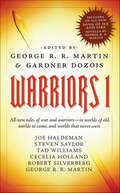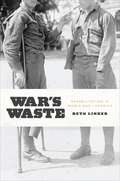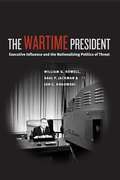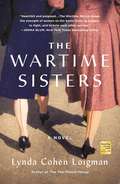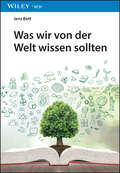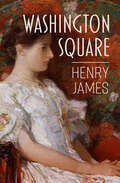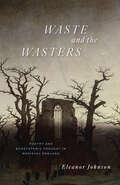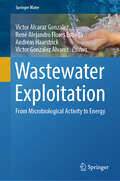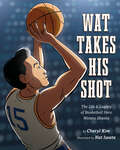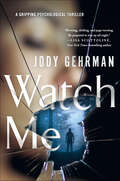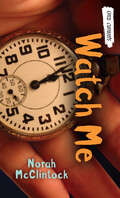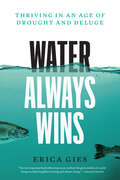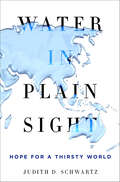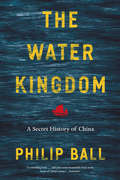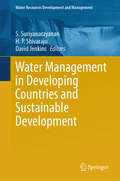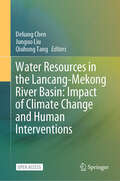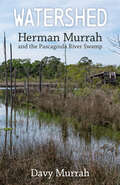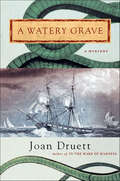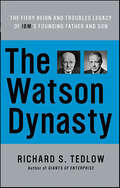- Table View
- List View
Wardship and the Welfare State: Native Americans and the Formation of First-Class Citizenship in Mid-Twentieth-Century America (New Visions in Native American and Indigenous Studies)
by Mary KlannWardship and the Welfare State examines the ideological dimensions and practical intersections of public policy and Native American citizenship, Indian wardship, and social welfare rights after World War II. By examining Native wardship&’s intersections with three pieces of mid-twentieth-century welfare legislation—the 1935 Social Security Act, the 1942 Servicemen&’s Dependents Allowance Act, and the 1944 GI Bill—Mary Klann traces the development of a new conception of first-class citizenship.Wardship and the Welfare State explores how policymakers and legislators have defined first-class citizenship against its apparent opposite, the much older and fraught idea of Indian wardship. Wards were considered dependent, while first-class citizens were considered independent. Wards were thought to receive gratuitous aid from the government, while first-class citizens were considered responsible. Critics of the federal welfare state&’s expansion in the 1930s through 1960s feared that as more Americans received government aid, they too could become dependent wards, victims of the poverty they saw on reservations. Because critics believed wardship prevented Native men and women from fulfilling expectations of work, family, and political membership, they advocated terminating Natives&’ trust relationships with the federal government. As these critics mistakenly equated wardship with welfare, state officials also prevented Native people from accessing needed welfare benefits. But to Native peoples wardship was not welfare and welfare was not wardship. Native nations and pan-Native organizations insisted on Natives&’ government-to-government relationships with the United States and maintained their rights to welfare benefits. In so doing, they rejected stereotyped portrayals of Natives&’ perpetual poverty and dependency and asserted and defined tribal sovereignty. By illuminating how assumptions about &“gratuitous&” government benefits limit citizenship, Wardship and the Welfare State connects Native people to larger histories of race, inequality, gender, and welfare in the twentieth-century United States.
The Warming: A Thriller
by Stanley JohnsonFor fans of Michael Crichton and Dan Brown: a fast-paced, blazingly smart thriller that will send your temperature rising.Charles Hodson is on the trail of his brother, who has disappeared in the depths of the Brazilian rainforest. For Charles, an intrepid journalist, the rescue mission is personal – but it becomes something much more terrifying when he uncovers evidence of a global conspiracy surrounding a large deposit of a rare substance: a mineral that could solve the planet's climate-change crisis.Bolting between the lush South American jungle and cosmopolitan Amsterdam, from the remote Falkland Islands to the forbidding frozen zone of Antarctica, The Warming is a pulse-pounding adventure as entertaining as it is intelligent.
Warnings and Risk Communication
by Michael S. Wogalter David M. Dejoy Kenneth R. LaugheryWith contributions from leading international experts, this book provides a comprehensive review of warnings and risk communications. The authors explain how best to communicate warnings, whether certain communications are effective, and what factors influence the communication process and address the major issues in theory, research, and applications of warnings and risk communication. The book is an authoritative sourcebook on the theory, research, and applications in the field. It provides a resource for professionals and academics in diverse domains that range from human factors/ergonomics, engineering psychology, marketing, and design, to industry, government, and litigation.
A Warrior of the People: How Susan La Flesche Overcame Racial and Gender Inequality to Become America's First Indian Doctor
by Joe Starita"An important and riveting story of a 19th-century feminist and change agent. Starita successfully balances the many facts with vivid narrative passages that put the reader inside the very thoughts and emotions of La Flesche." —Chicago TribuneOn March 14, 1889, Susan La Flesche Picotte received her medical degree—becoming the first Native American doctor in U.S. history. She earned her degree thirty-one years before women could vote and thirty-five years before Indians could become citizens in their own country. By age twenty-six, this fragile but indomitable Native woman became the doctor to her tribe. Overnight, she acquired 1,244 patients scattered across 1,350 square miles of rolling countryside with few roads. Her patients often were desperately poor and desperately sick—tuberculosis, small pox, measles, influenza—families scattered miles apart, whose last hope was a young woman who spoke their language and knew their customs.This is the story of an Indian woman who effectively became the chief of an entrenched patriarchal tribe, the story of a woman who crashed through thick walls of ethnic, racial and gender prejudice, then spent the rest of her life using a unique bicultural identity to improve the lot of her people—physically, emotionally, politically, and spiritually. Joe Starita's A Warrior of the People is the moving biography of Susan La Flesche Picotte’s inspirational life and dedication to public health, and it will finally shine a light on her numerous accomplishments.
Warriors 1 (Warriors Anthologies)
by Joe Haldeman Steven SaylorFrom George R. R. Martin's Introduction to Warriors: "People have been telling stories about warriors for as long as they have been telling stories. Since Homer first sang the wrath of Achilles and the ancient Sumerians set down their tales of Gilgamesh, warriors, soldiers, and fighters have fascinated us; they are a part of every culture, every literary tradition, every genre. All Quiet on the Western Front, From Here to Eternity, and The Red Badge of Courage have become part of our literary canon, taught in classrooms all around the country and the world. Our contributors make up an all-star lineup of award-winning and bestselling writers, representing a dozen different publishers and as many genres. We asked each of them for the same thing—a story about a warrior. Some chose to write in the genre they're best known for. Some decided to try something different. You will find warriors of every shape, size, and color in these pages, warriors from every epoch of human history, from yesterday and today and tomorrow, and from worlds that never were. Some of the stories will make you sad, some will make you laugh, and many will keep you on the edge of your seat." The stories in the first mass market volume of this book are:Introduction: Stories of the Spinner Rack, by George R. R. MartinForever Bound, by Joe HaldemanThe Eagle and the Rabbit, by Steven SaylorAnd Ministers of Grace, by Tad WilliamsThe King of Norway, by Cecelia HollandDefenders of the Frontier, by Robert SilverbergThe Mystery Knight, by George R. R. MartinMany of these writers are bestsellers. All of them are storytellers of the highest quality. Together they make a volume of unforgettable reading.At the Publisher's request, this title is being sold without Digital Rights Management Software (DRM) applied.
War's Waste: Rehabilitation in World War I America
by Beth LinkerWith US soldiers stationed around the world and engaged in multiple conflicts, Americans will be forced for the foreseeable future to come to terms with those permanently disabled in battle. At the moment, we accept rehabilitation as the proper social and cultural response to the wounded, swiftly returning injured combatants to their civilian lives. But this was not always the case, as Beth Linker reveals in her provocative new book, War’s Waste. Linker explains how, before entering World War I, the United States sought a way to avoid the enormous cost of providing injured soldiers with pensions, which it had done since the Revolutionary War. Emboldened by their faith in the new social and medical sciences, reformers pushed rehabilitation as a means to “rebuild” disabled soldiers, relieving the nation of a monetary burden and easing the decision to enter the Great War. Linker’s narrative moves from the professional development of orthopedic surgeons and physical therapists to the curative workshops, or hospital spaces where disabled soldiers learned how to repair automobiles as well as their own artificial limbs. The story culminates in the postwar establishment of the Veterans Administration, one of the greatest legacies to come out of the First World War.
The Wartime President: Executive Influence and the Nationalizing Politics of Threat (Chicago Ser. On International And Domestic Institutions Ser.)
by William G. Howell Saul P. Jackman Jon C. Rogowski“It is the nature of war to increase the executive at the expense of the legislative authority,” wrote Alexander Hamilton in the Federalist Papers. The balance of power between Congress and the president has been a powerful thread throughout American political thought since the time of the Founding Fathers. And yet, for all that has been written on the topic, we still lack a solid empirical or theoretical justification for Hamilton’s proposition. For the first time, William G. Howell, Saul P. Jackman, and Jon C. Rogowski systematically analyze the question. Congress, they show, is more likely to defer to the president’s policy preferences when political debates center on national rather than local considerations. Thus, World War II and the post-9/11 wars in Afghanistan and Iraq significantly augmented presidential power, allowing the president to enact foreign and domestic policies that would have been unattainable in times of peace. But, contrary to popular belief, there are also times when war has little effect on a president’s influence in Congress. The Vietnam and Gulf Wars, for instance, did not nationalize our politics nearly so much, and presidential influence expanded only moderately. Built on groundbreaking research, The Wartime President offers one of the most significant works ever written on the wartime powers presidents wield at home.
The Wartime Sisters: A Novel
by Lynda Cohen LoigmanFor fans of Lilac Girls, the next powerful novel from the author of Goodreads Choice Awards semifinalist The Two-Family House about two sisters working in a WWII armory, each with a deep secret. "Loigman’s strong voice and artful prose earn her a place in the company of Alice Hoffman and Anita Diamant, whose readers should flock to this wondrous new book." —Pam Jenoff, New York Times bestselling author of The Orphan’s Tale"The Wartime Sisters shows the strength of women on the home front: to endure, to fight, and to help each other survive.” —Jenna Blum, New York Times and international bestselling author of The Lost Family and Those Who Save UsTwo estranged sisters, raised in Brooklyn and each burdened with her own shocking secret, are reunited at the Springfield Armory in the early days of WWII. While one sister lives in relative ease on the bucolic Armory campus as an officer’s wife, the other arrives as a war widow and takes a position in the Armory factories as a “soldier of production.” Resentment festers between the two, and secrets are shattered when a mysterious figure from the past reemerges in their lives."One of my favorite books of the year." —Fiona Davis, national bestselling author of The Dollhouse and The Masterpiece "A stirring tale of loyalty, betrayal, and the consequences of long-buried secrets.” —Kristina McMorris, New York Times bestselling author of The Edge of Lost and Sold on a Monday
Was wir von der Welt wissen sollten
by Jens BottDas Buch zum Mitreden in aktuellen Debatten in Wissenschaft und Gesellschaft Der Wunsch, die Welt verstehen zu wollen, ist so alt wie die Menschheit; wir suchen nach Erklärungen, benötigen Halt und Orientierung. Aus Annahmen und Überzeugungen, die uns plausibel erscheinen, formen wir unsere Weltbilder, Vorstellungen über die Beschaffenheit des Universums. Die jeweils herrschenden Vorstellungen haben sich mit der Zeit allerdings verändert. Bis zum Ende des Mittelalters lagen die Dinge noch einfach: Für die Menschen in Europa etwa war die Bibel die Quelle aller Wahrheit, ein universelles Sachbuch, das die Entstehung des Universums, die Artenvielfalt und den Ursprung des Sprachengewirrs erklärte, aber auch moralische Richtlinien vorgab. Mit der Zeit hat sich eine Reihe zentraler Theorien und Ideen herausgeschält, die den heutigen Wissenschafts-und Politikbetrieb prägen. Gleich, ob wir sie nun persönlich für richtig halten oder nicht, haben diese herrschenden Meinungen Einfluss auf unser tägliches Leben – und das mehr, als uns oftmals bewusst ist. Im ersten Teil des Buches (Die Natur) werden nach Darstellung der Grundlagendisziplin Mathematik zunächst die physikalischen Naturgesetze dargelegt, um dann zu zeigen, wie sich aus ihnen die Chemie und aus der Chemie die Biologie ergibt. Im Mittelpunkt stehen Newtons Mechanik, die Relativitätstheorie, die Quantenphysik und Darwins Evolutionstheorie. Das abschließende Kapitel erzählt die Naturgeschichte vom Urknall bis zum Erscheinen des Homo sapiens und fasst dabei die wesentlichen Aussagen noch einmal zusammen. Das erste Kapitel des zweiten Teils (Der Mensch) beschäftigt sich mit dem menschlichen Bewusstsein und leitet aus einer naturwissenschaftlichen Perspektive zu den geisteswissenschaftlichen Kapiteln Sprache (Ausdrucksform des Bewusstseins), Philosophie (Geschichte des Denkens), Gesellschaft (Theorie des Zusammenlebens) und Ökonomie (Umgang mit knappen Ressourcen) über. Das abschließende Kapitel erzählt die Menschheitsgeschichte bis heute, wobei wiederum die zentralen Aussagen noch einmal zusammengefasst werden.
Washington Square: Large Print
by Henry JamesA master of American literature presents a tragicomic, coming-of-age romance. Set in New York against the backdrop of 1880s high society, Washington Square is one of the most beloved novels from master Henry James, and its exploration of interfamily strife and power dynamics, as well as its early take on gender issues, continue to resonate with readers today. Catherine Sloper is the only child of the successful Dr. Austin Sloper, residing with the physician in an upscale home on the edge of Washington Square in New York City. Shy and plain, yet honest and good-natured, Catherine is regarded as a perpetual disappointment by her father, who becomes suspicious of her young fortune-hunting suitor, Morris Townsend. As snooping Aunt Lavinia Penniman works to push Catherine and Townsend together—and provides some much appreciated comic relief—Catherine&’s father threatens to cut his daughter off if she pushes forward with the courtship and accepts Townsend&’s ultimate proposal of marriage. However, the dashing Townsend is willing to take the bluff, and Catherine&’s future hangs on what has become a game. And while Dr. Sloper has reason to question Townsend&’s intentions, the situation soon takes on an aspect of cruel sport for the good doctor. Based on a true story told to the author by British actress Fanny Kemble, Washington Square has become a cherished favorite of readers everywhere. Originally serialized in magazines, it is one of the shorter novels in the Jamesian canon, but nevertheless stands as one of the writer&’s most enduring tragicomedies and the perfect introduction to the novelist and his work. This ebook has been professionally proofread to ensure accuracy and readability on all devices.
Waste and the Wasters: Poetry and Ecosystemic Thought in Medieval England
by Eleanor JohnsonA groundbreaking examination of ecological thought in medieval England. While the scale of today’s crisis is unprecedented, environmental catastrophe is nothing new. Waste and the Wasters studies the late Middle Ages, when a convergence of land contraction, soil depletion, climate change, pollution, and plague subsumed Western Europe. In a culture lacking formal scientific methods, the task of explaining and coming to grips with what was happening fell to medieval poets. The poems they wrote used the terms “waste” or “wasters” to anchor trenchant critiques of people’s unsustainable relationships with the world around them and with each other. In this book, Eleanor Johnson shows how poetry helped medieval people understand and navigate the ecosystemic crises—both material and spiritual—of their time.
Wastewater Exploitation: From Microbiological Activity to Energy (Springer Water)
by Andreas Haarstrick Victor Alcaraz Gonzalez René Alejandro Flores Estrella Victor Gonzalez AlvarezWith all the current efforts to use non-fossil sources as a starting point for future energy solutions, consideration is also being given to using microbial activities as a direct or indirect source of energy production. This ranges from the use of algae as biomass or as H2 producers, anaerobic microorganisms to produce methane, hydrogen, and even electricity directly. This book deals with both theoretical and technical possibilities of using anaerobic microorganisms in combination with wastewater as a substrate source to produce biofuels and bioenergy in the form of biomass, CH4 and H2 as well as the corresponding power densities and electricity quantities in economically justifiable processes. Unique process facilities are widely addressed; however, special interest is also placed in biorefinery and circular economy related concepts. The theoretical background as well as application examples are presented.
Wat Takes His Shot: The Life & Legacy of Basketball Hero Wataru Misaka
by Cheryl KimThe stirring biography of Japanese American basketball star Wataru Misaka--the first person of color to play in the NBA!As a kid, Wataru Misaka channeled his endless energy into playing sports. Every Sunday, he raced to the park where his Japanese American community came together to play basketball. Wat wasn't the tallest on the team, but he was fast and loved the game! Encouraged by his father to always do his best, Wat applied this mentality to every aspect and challenge in his life. Wat was a college student when the US government forced more than 122,000 Japanese Americans living on the West Coast into incarceration camps during WWII. He overcame racism and segregation to join his college's basketball team but despite Wat's impressive skills, he was treated as an outsider because he was Japanese American. Wat kept his eye on the ball, and his team-player mentality made him shine on and off the court. He became an inspiration to his Japanese American community. After helping Utah University's basketball team win the national championship in 1947, Wat was drafted by the New York Knicks, making him the first person of color to play in the NBA. Wat's motivational story of rising to any challenge and bringing your best to everything you do is a reminder of the power we each have to inspire others--if we just take our shot!
Watch Me: A Gripping Psychological Thriller
by Jody Gehrman"Riveting, chilling, and page-turning. Be prepared to stay up all night." -- New York Times bestselling author Lisa ScottolineFor fans of dark and twisty psychological thrillers, Watch Me is a riveting novel of suspense about how far obsession can go.Kate Youngblood is disappearing. Muddling through her late 30s as a creative writing professor at Blackwood college, she’s dangerously close to never being noticed again. The follow-up novel to her successful debut tanked. Her husband left her for a woman ten years younger. She’s always been bright, beautiful, independent and a little wild, but now her glow is starting to vanish. She’s heading into an age where her eyes are less blue, her charm worn out, and soon no one will ever truly look at her, want to know her, again. Except one.Sam Grist is Kate’s most promising student. An unflinching writer with razor-sharp clarity who gravitates towards dark themes and twisted plots, his raw talent is something Kate wants to nurture into literary success. But he’s not there solely to be the best writer. He’s been watching her. Wanting her. Working his way to her for years. As Sam slowly makes his way into Kate’s life, they enter a deadly web of dangerous lies and forbidden desire. But how far will his fixation go? And how far will she allow it?A gripping novel exploring intense obsession and illicit attraction, Jody Gehrman introduces a world where what you desire most may be the most dangerous thing of all.
Watch Me (Orca Currents)
by Norah McClintockAt first Kaz intends to help the old lady who's fallen in the park. But then Kaz starts thinking about how he never gets what he wants. The next thing he knows, he's running away with her purse. The purse contains only five dollars and a battered watch. When Kaz learns who the old woman is and where the watch came from, he begins to understand consequences in a new way. This short novel is a high-interest, low-reading level book for middle-grade readers who are building reading skills, want a quick read or say they don’t like to read! The epub edition of this title is fully accessible.
Watch Us Dance: A Novel
by Leila SlimaniThe rebellions within an interracial family play out against the countercultural rebellions of the 1960s in this sexy, stylish, sophisticated new novel by the award-winning, internationally bestselling author of The Perfect Nanny and In the Country of Others.It&’s the 1960s, and the air is electric. On the cusp of adulthood, two biracial siblings—their father is Moroccan, their mother French—search for their place in a newly independent Morocco brimming with both possibility and peril.Aicha, strong-willed and strait-laced, aspires to become a doctor and spends most of her time studying. Her free-spirited younger brother, Selim, falls in with the American and European hippies descending en masse on Tangier and Casablanca and Essaouira to do drugs and practice free love. Children of the revolution, now dreaming of a radiant future and experiencing the ecstatic first flush of desire against the backdrop of a country intoxicated by its own sense of freedom, Aicha and Selim soon find the ideals of their youth colliding with the realities of racism and corruption, as Moroccans once united against their colonizer make a grab for wealth and influence, and the national spirit of communal celebration gives way to elites telling everyone else to &“watch us dance.&”In her latest international bestseller, Leila Slimani draws on her family&’s inspiring story to deliver a tense, provocative, page-turning novel about one family&’s, and one country&’s, coming of age in the face of the seductions of power and privilege.
Water Always Wins: Thriving in an Age of Drought and Deluge
by Erica GiesWinner of the Rachel Carson Award for Excellence in Environmental Journalism, Water Always Wins is a hopeful journey around the world and across time, illuminating better ways to live with water. Nearly every human endeavor on the planet was conceived and constructed with a relatively stable climate in mind. But as new climate disasters remind us every day, our world is not stable—and it is changing in ways that expose the deep dysfunction of our relationship with water. Increasingly severe and frequent floods and droughts inevitably spur calls for higher levees, bigger drains, and longer aqueducts. But as we grapple with extreme weather, a hard truth is emerging: our development, including concrete infrastructure designed to control water, is actually exacerbating our problems. Because sooner or later, water always wins. In this quietly radical book, science journalist Erica Gies introduces us to innovators in what she calls the Slow Water movement who start by asking a revolutionary question: What does water want? Using close observation, historical research, and cutting-edge science, these experts in hydrology, restoration ecology, engineering, and urban planning are already transforming our relationship with water. Modern civilizations tend to speed water away, erasing its slow phases on the land. Gies reminds us that water’s true nature is to flex with the rhythms of the earth: the slow phases absorb floods, store water for droughts, and feed natural systems. Figuring out what water wants—and accommodating its desires within our human landscapes—is now a crucial survival strategy. By putting these new approaches to the test, innovators in the Slow Water movement are reshaping the future.
Water in Plain Sight: Hope for a Thirsty World
by Judith D. SchwartzWater scarcity is on everyone's mind. Long taken for granted, water availability has entered the realm of economics, politics, and people's food and lifestyle choices. But as anxiety mounts - even as a swath of California farmland has been left fallow and extremist groups worldwide exploit the desperation of people losing livelihoods to desertification - many are finding new routes to water security with key implications for food access, economic resilience, and climate change.Water does not perish, nor require millions of years to form as do fossil fuels. However, water is always on the move. In this timely, important book, Judith D. Schwartz presents a refreshing perspective on water that transcends zero-sum thinking. By allying with the water cycle, we can revive lush, productive landscapes. Like the river in rural Zimbabwe that, thanks to restorative grazing, now flows miles further than in living memory. Or the food forest of oranges, pomegranates, and native fruit-bearing plants in Tucson, grown through harvesting urban wastewater. Or the mini-oasis in West Texas nourished by dew.Animated by stories from around the globe, Water In Plain Sight is an inspiring reminder that fixing the future of our drying planet involves understanding what makes natural systems thrive.
The Water Kingdom: A Secret History of China
by Philip BallFrom the Yangtze to the Yellow River, China is traversed by great waterways, which have defined its politics and ways of life for centuries. Water has been so integral to China’s culture, economy, and growth and development that it provides a window on the whole sweep of Chinese history. In The Water Kingdom, renowned writer Philip Ball opens that window to offer an epic and powerful new way of thinking about Chinese civilization. Water, Ball shows, is a key that unlocks much of Chinese culture. In The Water Kingdom, he takes us on a grand journey through China’s past and present, showing how the complexity and energy of the country and its history repeatedly come back to the challenges, opportunities, and inspiration provided by the waterways. Drawing on stories from travelers and explorers, poets and painters, bureaucrats and activists, all of whom have been influenced by an environment shaped and permeated by water, Ball explores how the ubiquitous relationship of the Chinese people to water has made it an enduring metaphor for philosophical thought and artistic expression. From the Han emperors to Mao, the ability to manage the waters ? to provide irrigation and defend against floods ? was a barometer of political legitimacy, often resulting in engineering works on a gigantic scale. It is a struggle that continues today, as the strain of economic growth on water resources may be the greatest threat to China’s future.The Water Kingdom offers an unusual and fascinating history, uncovering just how much of China’s art, politics, and outlook have been defined by the links between humanity and nature.
Water Management in Developing Countries and Sustainable Development (Water Resources Development and Management)
by David Jenkins S. Suriyanarayanan H. P. ShivarajuThis book provides information on sustainable water resource management strategies that present innovative ways to conserve both quality and quantity of water in developing countries. The book comprises of 24 chapters contributed by authors from 14 countries, namely, Cameroon, China, Cyprus, India, Indonesia, Italy, Namibia, the Netherlands, Norway, Portugal, South Africa, the United Kingdom, the United States of America and Zimbabwe. This book will be of great interest to researchers, practitioners, water resource managers, policy and decision makers, international institutions, governmental and non-governmental organizations, educators, as well as students.
Water Resources in the Lancang-Mekong River Basin: Impact of Climate Change and Human Interventions
by Qiuhong Tang Deliang Chen Junguo LiuThis open access book provides a comprehensive, up-to-date picture of the current state of knowledge covering climate change, surface water change, arsenic pollution, water utilization, water-food-energy nexus, water related hazards, water management, and water governance in the Lancang-Mekong River Basin. Considering the widely concerned fact that the climate change and human intervention induced impacts on water will bring unprecedented threats to human societies and ecosystems, the book intends to support UN’s sustainable development goals through sustainable use of water by providing the most accurate and updated information on climate and water changes in a consistent way. Underlying all aspects of the book is a strong commitment to assessing the science comprehensively, without bias and in a way that is relevant to policy but not policy prescriptive. It can provide implications to support decision-makers and stakeholders for integrated water resources management and sustainable development at all levels.
Watershed: Herman Murrah and the Pascagoula River Swamp
by Davy MurrahThe Pascagoula River is the largest unobstructed river in the contiguous United States. Because of this lack of restraint, the river has been left to rise and fall naturally with the seasons, overflowing annually into the adjoining bottomland forest. This phenomenon makes the Pascagoula River one of the wildest rivers, surrounded by some of the most ecologically diverse woodlands, in North America.Herman Murrah (1935–2002) lived his entire life on the banks and in the swamp surrounding this river in southeast Mississippi. Watershed: Herman Murrah and the Pascagoula River Swamp recounts pivotal moments in Herman’s life and in Mississippi’s conservation history more broadly. In this book, Herman’s eldest son, Davy, details the adventures that continue to inspire young conservationists in the fight to protect our remaining natural ecosystems.As a young adult, Herman worked as a game warden in the Pascagoula River Swamp. When the Pascagoula Hardwood Company, then owners of the swamp, decided to sell the vast tract of forest for clearcutting, Herman was incensed. Determined to protect this natural wonder, Herman teamed up with other visionaries to persuade the State of Mississippi to purchase the land and preserve it in perpetuity to the benefit of future generations of humans and wildlife alike. Eventually, the state agreed and finalized the purchase. Herman was appointed area manager for the upper portion of the newly designated Pascagoula River Wildlife Management Area. He dedicated the remainder of his life to preserving, protecting, and improving the swamp for the good of south Mississippi.
A Watery Grave: A Mystery (Wiki Coffin Mysteries #1)
by Joan DruettThe year is 1838, and after more than ten years in the planning, the famous United States Exploring Expedition is set to launch into uncharted waters from the coast of Virginia. A convoy of seven ships filled with astronomers, mapmakers, naturalists, and the sailors charged with getting them around the world, the "Ex. Ex." is finally underway, with much fanfare.Aboard the convoy as ship's linguist is Wiki Coffin. Half New Zealand Maori and half American, Wiki speaks numerous languages and is expected to help the crew navigate the Pacific islands that are his native heritage. But just before departure Wiki, subject to the unfortunate bigotry of the time, is arrested for a vicious murder he didn't commit.The convoy sails off, but just before the ships are out of reach Wiki is exonerated, set free to catch up with his ship and sail on. The catch: the local sheriff is convinced that the real murderer is aboard one of the seven ships of the expedition, and Wiki is deputized to identify the killer and bring him to justice. Full of the evocative maritime detail and atmosphere that have won her numerous awards for her nonfiction, Joan Druett's A Watery Grave is the mystery debut of a masterful maritime writer.
Watery Planet: How a water crisis is impacting our world
by Anna ClaybourneWatery Planet offers young readers a clear, insightful look at Earth's ongoing water challenges.Water makes our life on Earth possible. We need water not just to drink and keep clean, but also for agriculture, industry, transport and much, much more. But despite having an enormous amount of water on Earth, only 1 per cent of it is available for us to use and it's at increasing risk.Watery Planet looks at the reasons behind our looming water crisis - from uneven distribution to water wastage, pollution and climate change. It explores how floods, droughts and rising sea levels are becoming a stark reality as the world warms and describes how we are adapting to these challenges. It also looks at some positive, practical solutions to our water problems and explains how we can all do our part to help save Earth's most precious resource.Contents:A WHOLE WORLD OF WATER WE ALL NEED WATER! HOW WE GET WATER IS THERE ENOUGH WATER? WATER AND HEALTH CASE STUDY: COLLECTING WATER IN ETHIOPIA WATER POLLUTION WATER AND GLOBAL WARMING FLOODS AND DROUGHTS CASE STUDY: PAKISTAN FLOODS RISING SEA LEVELS WATER AND NATURE WATER AND WILDLIFE CASE STUDY: THIRSTY AVOCADOS DOING THINGS DIFFERENTLY WATER FOR THE WORLD CASE STUDY: THE ARAL SEA WATERY HOMES WHAT CAN YOU DO? THE FUTURE OF WATER GLOSSARY FURTHER READING INDEX Titles in this series:Plastic PlanetHot PlanetRecycled PlanetSustainable PlanetExtinction PlanetPeaceful Planet?Unequal Planet
The Watson Dynasty: The Fiery Reign and Troubled Legacy of IBM's Founding Father and Son
by Richard S. TedlowFor an extraordinary fifty-seven-year period, one of the nation's largest and fastest-growing companies was run by two men who were flesh and blood. The chief executives of the International Business Machines Corporation from 1914 until 1971 were Thomas J. Watson and Thomas J. Watson, father and son. That great corporation bears the imprint of both men -- their ambitions and their strengths -- but it also bears the consequences of a family that was in near-constant conflict.Sometimes wrong but never in doubt, both Watsons had clear -- and farsighted -- visions of what their company could become. They also had volcanic tempers. Their fights with each other combined with their commitment to leadership and excellence made IBM one of the most rewarding, yet gut-clutching firms to work for in the history of American business.We are accustomed to describing professional behavior as if men and women leave their emotions and vulnerabilities at home each day. In the case of the Watsons, filial and sibling strife could not be excluded from the office. In closely studying the desires and frustrations of the Watson family, eminent historian Richard S. Tedlow has produced something more than a family portrait or a company history. He has raised the nearly forbidden issue of the role of emotion in corporate life.This book explores the interplay between the person- alities of these two extraordinary men and the firm they created. Both Watsons had deeply held beliefs about what a corporation is and should be. These ideas helped make "Big Blue" the bluest of blue-chip stocks during the Watsons' tenure. These very beliefs, however, also sowed the seeds for IBM's disasters in the late 1980s and early 1990s, when the company had lost sight of the original meaning behind many of the practices each man put into place.Tracing the family's idiosyncratic ability to cope with each other's weaknesses but not their strengths, The Watson Dynasty is a book for every person who ever went to work but didn't want to check his personality at the door.
